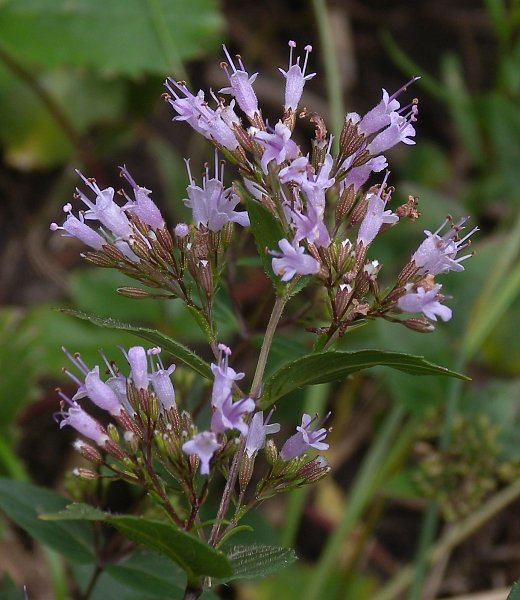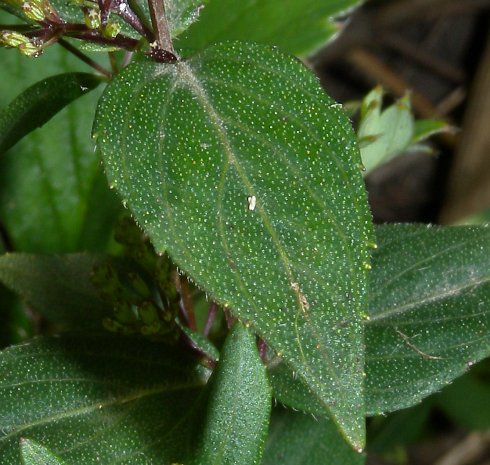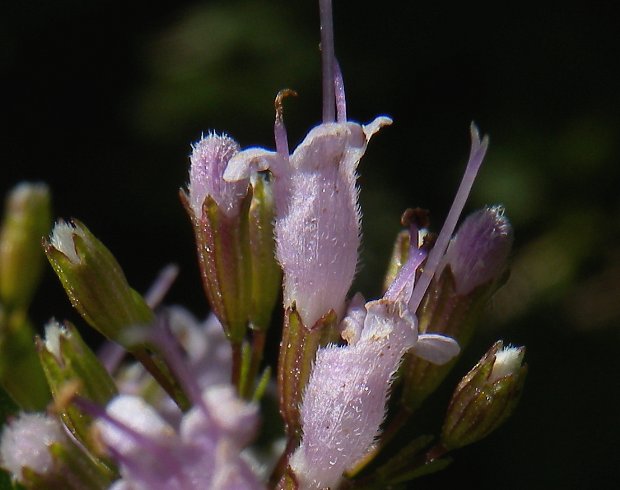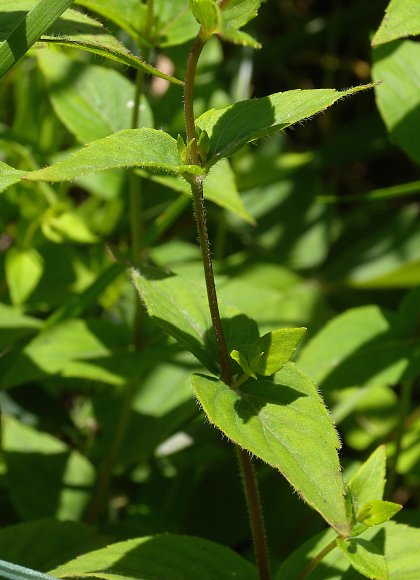
Each flower is 6-8 mm. (1/4" to 1/3") in length, consisting of a tubular corolla with 4 spreading lobes, a tubular calyx with 5 teeth, 2 strongly exserted stamens, and a 4-parted ovary with a strongly exserted style. The corolla is pink or lavender (rarely white) and softly hairy along its exterior; its 4 lobes are similar in size. The calyx is light green to light reddish purple with 10 raised nerves that are a darker shade of green or reddish purple; it is glandular-punctate. The teeth of the calyx are triangular in shape and similar in size; they are shorter than the tube of the calyx. The filaments of the stamens are white to light purple, while their anthers are pink to lavender, becoming brown with age. The slender style is white to light purple; it has a bifurcated tip. The calyx is noticeably shorter than the corolla, while the stamens and style are almost twice the length of the corolla. The blooming period occurs from late summer to mid-autumn, lasting about 1½ months. Afterwards, each flower is replaced by 4 tiny brown nutlets. These nutlets are about 1 mm. long, about 0.7 mm. across, broadly ellipsoid and bluntly 3-angled in shape; they are small enough to be blown about by the wind. The root system is fibrous, forming small root-buds for next year's stems.

Cultivation: The preference is partial sun to medium shade, mesic to dry conditions, and shallow rocky soil that is somewhat acidic. Excessive moisture on the leaves can cause a rust-fungus to develop. This plant can also adapt to ordinary garden soil if taller and more aggressive ground vegetation is kept away from it.
Range & Habitat: The native American Dittany is occasional to locally common in SW Illinois and the southern tip of Illinois (see Distribution Map). Illinois lies along the northern range-limit of this plant. Habitats include upland rocky woodlands, thinly wooded bluffs, upper wooded slopes, and semi-shaded areas of sandstone cliffs. American Dittany is found in association with upland oak-hickory woodlands, especially where sandstone is close to the soil surface. It is usually found in high quality natural areas where ground vegetation is relatively sparse.

Faunal Associations: Very little information is currently available about the floral-faunal relationships of this plant. The flowers are probably cross-pollinated by various flies (Blanchan, 1900) and also bees. According to Rudolph et al. (2006), it is a moderately important nectar plant of migrating Monarch butterflies during the autumn. The caterpillars of a monophagous or oligophagous moth, Stephensia cunilae, mine the leaves (Braun, 1948). This plant is also recorded as one of the hosts of a polyphagous leaf beetle, Capraita circumdata (Clark et al., 2004). Because of the strong mint fragrance of the foliage, mammalian herbivores (deer, groundhogs, etc.) usually avoid its consumption.
Photographic Location: The wildflower garden of the webmaster in Urbana, Illinois.

Comments: American Dittany (Cunila origanoides) can adapt to shade gardens and its pinkish flowers provide a welcome alternative to the more common autumn-blooming goldenrods and asters. The common name of this plant may refer to its resemblance to a Mediterranean species, Dittany of Crete (Origanum dictamnus). American Dittany also resembles the cultivated culinary herbs, Oregano (Origanum vulgare) and Marjoram (Origanum majorana), except its flowers have only 2 fertile stamens rather than 4 fertile stamens, its leaves are usually larger in size, and its leaf tips are more acute than those of the latter species. American Dittany can be distinguished from other similar species in the Mint family by means of a combination of the following characteristics: 1) the presence of only 2 fertile stamens, rather than 4 fertile stamens, on its flowers, 2) the strongly exserted stamens and style of its flowers, 3) the conspicuous punctate glands on its leaves and the calyces of its flowers, 4) the lack of conspicuous lips on its flowers, 3) the similarity of the 5 teeth on its calyces, 4) the relatively broad shape of its leaves that taper into acute tips, 5) the sessile nature of its leaves, and 6) the strong mint fragrance of its foliage. In addition to American Dittany, Cunila origanoides has several other common names in circulation; they include Stone Mint, Common Dittany, Sweet Horsemint, Frost Mint, Frost Flowers, and Fairy Skirts. During early frosts of the autumn, this plant sometimes forms white 'frost flowers' near its stem bases; they develop from the bursting and freezing of exposed sap.